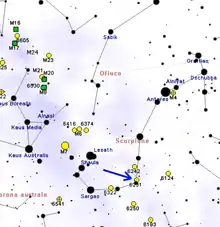NGC 6231
NGC 6231 (also known as Caldwell 76) is an open cluster in the southern sky located half a degrees north of Zeta Scorpii. NGC 6231 is part of a swath of young, bluish stars in the constellation Scorpius known as the Scorpius OB1 association.[4] The star Zeta1 (HR 6262) is a member of this association, while its brighter apparent partner, Zeta2 (HR 6271), is only 150 ly from Earth and so is not a member.
| NGC 6231 | |
|---|---|
 | |
| Observation data (J2000.0 epoch) | |
| Right ascension | 16h 54m |
| Declination | −41° 48′ |
| Distance | 5,600±400 ly (1,700±130 parsec[1]) |
| Apparent magnitude (V) | 2.6 |
| Apparent dimensions (V) | 15.0′ |
| Physical characteristics | |
| Estimated age | 2–7 million years[2][3] |
| Other designations | NGC 6171, Caldwell 76, Collinder 315, Melotte 153, De Cheseaux 9, Dunlop 499, Ha. I.7, Lacaille II.13 |
| Associations | |
| Constellation | Scorpius |

This cluster is estimated to be about 2–7 million years old,[2][3] and is approaching the Solar System at 22 km/s. The cluster and association lie in the neighboring Sagittarius Arm of the Milky Way. Zeta1 Scorpii (spectral type O8 and magnitude 4.71.[5]) is the brightest star in the association, and one of the most radiant stars known in the galaxy.[6] NGC 6231 was used to measure the binary fraction of B-type stars: 52 ± 8%, indicating that B-type stars are commonly found in binary systems, but not as commonly as in O-type stars.[3]
NGC 6231 also includes three Wolf-Rayet stars: HD 151932, HD 152270,[7] and HD 152408.[8]
Discovery
The cluster was discovered by Giovanni Batista Hodierna before 1654. Hodierna listed it as Luminosae[9] in his catalogue of deep sky observations. This catalogue was included in his book De Admirandis Coeli Characteribuse published in 1654 at Palermo. It was independently observed by other astronomers after Hodierna, including Edmond Halley (1678), Jean-Philippe de Cheseaux (1745–46), and Abbe Lacaille (1751–52).
Common names
The cluster forms the head of the False Comet, a wider collection of stars from Scorpius OB1 running northward from Zeta Scorpii and NGC 6231 roughly halfway toward Mu Scorpii. The tail is formed by two clusters, Collinder 316 and Trumpler 24. Trumpler 24 is surrounded by the emission nebula IC 4628, also known as the Prawn Nebula, where the tail appears to fan out.
The cluster is also sometimes known as The Northern Jewel Box,[10] due to its similar appearance to the NGC 4755, the Jewel Box cluster, which is further south in the sky.
See also
Notes
- Kuhn, Michael A.; Hillenbrand, Lynne A.; Sills, Alison; Feigelson, Eric D.; Getman, Konstantin V. (2018). "Kinematics in Young Star Clusters and Associations with Gaia DR2". The Astrophysical Journal. 870 (1): 32. arXiv:1807.02115. Bibcode:2019ApJ...870...32K. doi:10.3847/1538-4357/aaef8c. S2CID 119328315.
- Kuhn, M. A.; Medina, N.; Getman, K. V.; et al. (2017). "The Structure of the Young Star Cluster NGC 6231. I. Stellar Population". The Astronomical Journal. 154 (3): 87. arXiv:1706.00017. Bibcode:2017AJ....154...87K. doi:10.3847/1538-3881/aa76e8. S2CID 119435797.
- Banyard, G.; Sana, H.; Mahy, L.; Bodensteiner, J.; Villaseñor, J. I.; Evans, C. J. (2022). "The observed multiplicity properties of B-type stars in the Galactic young open cluster NGC 6231". Astronomy & Astrophysics. 658: A69. arXiv:2108.07814. Bibcode:2022A&A...658A..69B. doi:10.1051/0004-6361/202141037. S2CID 237194742.
- Reipurth, B. (2008). "Young Stars in NGC 6231 and the Sco OB1 Association". In Reipurth, B. (ed.). Handbook of Star Forming Regions, Volume II: The Southern Sky ASP Monograph Publications. Vol. 5. p. 401. Bibcode:2008hsf2.book..401R. ISBN 978-1-58381-670-7.
- Sky Catalogue 2000.0
- Crossen & Tirion, Binocular Astronomy, p. 119.
- Shylaja, B. S (1988). "Study of the Wolf-Rayet members of the cluster NGC 6231". Journal of Astrophysics and Astronomy. 9 (3): 161–172. Bibcode:1988JApA....9..161S. doi:10.1007/BF02715061. S2CID 121125488.
- The distinction between OIafpe and WNLha stars. A spectral analysis of HD 151804, HD 152408 and HDE 313846.
- Stars visible to the naked eye. It meanings "luminous" in Latin.
- Michael E. Bakich (July 17, 2014). "The Northern Jewel Box, globular cluster M12, and the Bug Nebula". astronomy.com. Retrieved August 5, 2019.
External links
- SEDS
- NGC 6231 at DOCdb (Deep Sky Observer's Companion)
- NGC 6231 on WikiSky: DSS2, SDSS, GALEX, IRAS, Hydrogen α, X-Ray, Astrophoto, Sky Map, Articles and images